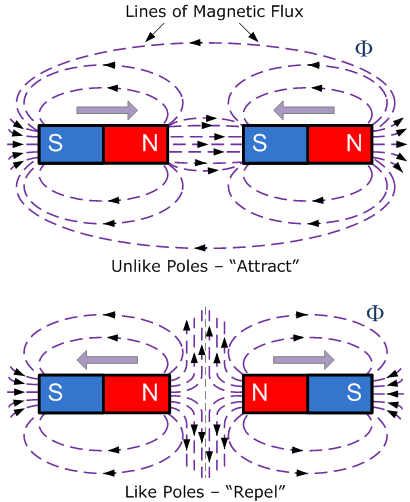
State whether True or False:
Like poles repel each other and unlike poles attract each other.
A.)True
B.)False
Answer
508.4k+ views
Hint: When like poles are brought together, all the electrons start spinning in the same direction. And when unlike poles are brought together, all the electrons start spinning in the opposite direction. Thus, like poles repel and unlike poles attract each other.
Complete answer:
Electrons in the atoms of any magnetic material spin around the nucleus mainly in one direction. Due to this more negative side and more positive side is formed in the magnet. This makes the north pole and south pole of the magnet. This difference creates a high attraction on one side of the magnet where the electrons are spinning compared to that on the other side where electrons are not spinning.
This magnetic force flows from a more negative side to a more positive side i.e. from north pole to south pole outside the magnet. This results in a magnetic field around the magnet. When we join the north pole and south pole of two different magnets, all the electrons start spinning in the same direction. This leads to a strong attraction. On the other hand, when we join north pole to north pole or south pole to south pole electrons are likely to reverse their direction in which they were spinning. This causes repulsion.

Thus, we can say, when like poles are brought together, they repel each other and when unlike poles are brought together, they attract.
So, the correct answer is “Option A”.
Note:
Size of the magnet affects its strength. When we increase the size of the magnet, there are proportionally more electrons to align either in the same direction or in reverse direction. This produces a stronger magnetic field as compared to a smaller piece of the same magnet.
Complete answer:
Electrons in the atoms of any magnetic material spin around the nucleus mainly in one direction. Due to this more negative side and more positive side is formed in the magnet. This makes the north pole and south pole of the magnet. This difference creates a high attraction on one side of the magnet where the electrons are spinning compared to that on the other side where electrons are not spinning.
This magnetic force flows from a more negative side to a more positive side i.e. from north pole to south pole outside the magnet. This results in a magnetic field around the magnet. When we join the north pole and south pole of two different magnets, all the electrons start spinning in the same direction. This leads to a strong attraction. On the other hand, when we join north pole to north pole or south pole to south pole electrons are likely to reverse their direction in which they were spinning. This causes repulsion.

Thus, we can say, when like poles are brought together, they repel each other and when unlike poles are brought together, they attract.
So, the correct answer is “Option A”.
Note:
Size of the magnet affects its strength. When we increase the size of the magnet, there are proportionally more electrons to align either in the same direction or in reverse direction. This produces a stronger magnetic field as compared to a smaller piece of the same magnet.
Recently Updated Pages
Master Class 12 Business Studies: Engaging Questions & Answers for Success

Master Class 12 Economics: Engaging Questions & Answers for Success

Master Class 12 English: Engaging Questions & Answers for Success

Master Class 12 Maths: Engaging Questions & Answers for Success

Master Class 12 Social Science: Engaging Questions & Answers for Success

Master Class 12 Chemistry: Engaging Questions & Answers for Success

Trending doubts
What are the major means of transport Explain each class 12 social science CBSE

Which are the Top 10 Largest Countries of the World?

Draw a labelled sketch of the human eye class 12 physics CBSE

Explain sex determination in humans with line diag class 12 biology CBSE

The pH of the pancreatic juice is A 64 B 86 C 120 D class 12 biology CBSE

Explain sex determination in humans with the help of class 12 biology CBSE




